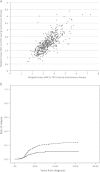Mercaptopurine/Methotrexate maintenance therapy of childhood acute lymphoblastic leukemia: clinical facts and fiction
- PMID: 24936744
- PMCID: PMC4222610
- DOI: 10.1097/MPH.0000000000000206
Mercaptopurine/Methotrexate maintenance therapy of childhood acute lymphoblastic leukemia: clinical facts and fiction
Abstract
The antileukemic mechanisms of 6-mercaptopurine (6MP) and methotrexate (MTX) maintenance therapy are poorly understood, but the benefits of several years of myelosuppressive maintenance therapy for acute lymphoblastic leukemia are well proven. Currently, there is no international consensus on drug dosing. Because of significant interindividual and intraindividual variations in drug disposition and pharmacodynamics, vigorous dose adjustments are needed to obtain a target degree of myelosuppression. As the normal white blood cell counts vary by patients' ages and ethnicity, and also within age groups, identical white blood cell levels for 2 patients may not reflect the same treatment intensity. Measurements of intracellular levels of cytotoxic metabolites of 6MP and MTX can identify nonadherent patients, but therapeutic target levels remains to be established. A rise in serum aminotransferase levels during maintenance therapy is common and often related to high levels of methylated 6MP metabolites. However, except for episodes of hypoglycemia, serious liver dysfunction is rare, the risk of permanent liver damage is low, and aminotransferase levels usually normalize within a few weeks after discontinuation of therapy. 6MP and MTX dose increments should lead to either leukopenia or a rise in aminotransferases, and if neither is experienced, poor treatment adherence should be considered. The many genetic polymorphisms that determine 6MP and MTX disposition, efficacy, and toxicity have precluded implementation of pharmacogenomics into treatment, the sole exception being dramatic 6MP dose reductions in patients who are homozygous deficient for thiopurine methyltransferase, the enzyme that methylates 6MP and several of its metabolites. In conclusion, maintenance therapy is as important as the more intensive and toxic earlier treatment phases, and often more challenging. Ongoing research address the applicability of drug metabolite measurements for dose adjustments, extensive host genome profiling to understand diversity in treatment efficacy and toxicity, and alternative thiopurine dosing regimens to improve therapy for the individual patient.
Conflict of interest statement
The authors declare no conflict of interest.
Figures




Similar articles
-
Myelotoxicity after high-dose methotrexate in childhood acute leukemia is influenced by 6-mercaptopurine dosing but not by intermediate thiopurine methyltransferase activity.Cancer Chemother Pharmacol. 2015 Jan;75(1):59-66. doi: 10.1007/s00280-014-2613-7. Epub 2014 Oct 28. Cancer Chemother Pharmacol. 2015. PMID: 25347948 Free PMC article.
-
Measures of 6-mercaptopurine and methotrexate maintenance therapy intensity in childhood acute lymphoblastic leukemia.Cancer Chemother Pharmacol. 2016 Nov;78(5):983-994. doi: 10.1007/s00280-016-3151-2. Epub 2016 Sep 6. Cancer Chemother Pharmacol. 2016. PMID: 27600880
-
Prognostic importance of 6-mercaptopurine dose intensity in acute lymphoblastic leukemia.Blood. 1999 May 1;93(9):2817-23. Blood. 1999. PMID: 10216075 Clinical Trial.
-
Maintenance Treatment in Acute Lymphoblastic Leukemia: A Clinical Primer.Indian J Pediatr. 2024 Jan;91(1):47-58. doi: 10.1007/s12098-023-04687-6. Epub 2023 Jul 26. Indian J Pediatr. 2024. PMID: 37493925 Review.
-
Maintenance therapy for acute lymphoblastic leukemia: basic science and clinical translations.Leukemia. 2022 Jul;36(7):1749-1758. doi: 10.1038/s41375-022-01591-4. Epub 2022 Jun 2. Leukemia. 2022. PMID: 35654820 Free PMC article. Review.
Cited by
-
The Effect of NUDT15, TPMT, APEX1, and ITPA Genetic Variations on Mercaptopurine Treatment of Pediatric Acute Lymphoblastic Leukemia.Children (Basel). 2021 Mar 15;8(3):224. doi: 10.3390/children8030224. Children (Basel). 2021. PMID: 33804051 Free PMC article.
-
Tooth Abnormalities and Their Age-Dependent Occurrence in Leukemia Survivors.Cancers (Basel). 2023 Nov 15;15(22):5420. doi: 10.3390/cancers15225420. Cancers (Basel). 2023. PMID: 38001680 Free PMC article.
-
Preclinical evaluation of NUDT15-guided thiopurine therapy and its effects on toxicity and antileukemic efficacy.Blood. 2018 May 31;131(22):2466-2474. doi: 10.1182/blood-2017-11-815506. Epub 2018 Mar 23. Blood. 2018. PMID: 29572377 Free PMC article.
-
Incidence and determinants of hematotoxicity in acute lymphoblastic leukemia children who received 6-mercaptopurine based maintenance therapy in Addis Ababa, Ethiopia.PLoS One. 2023 Jun 2;18(6):e0286544. doi: 10.1371/journal.pone.0286544. eCollection 2023. PLoS One. 2023. PMID: 37267380 Free PMC article.
-
DNA polymerase gamma variants and hepatotoxicity during maintenance therapy of childhood acute lymphoblastic leukemia: is there a causal relationship?Pharmacogenomics J. 2023 Sep;23(5):105-111. doi: 10.1038/s41397-023-00303-0. Epub 2023 May 3. Pharmacogenomics J. 2023. PMID: 37138020 Free PMC article.
References
-
- Farber S, Diamond LK, Mercer RD, et al. Temporary remissions in acute leukemia in children produced by folic acid antagonist 4-aminopteroylglutamic acid (aminopterin). N Engl J Med. 1948;238:787–793. - PubMed
-
- Burchenal JH, Murphy ML, Ellison RR, et al. Clinical evaluation of a new antimetabolite, 6-mercaptopurine, in the treatment of leukemia and allied diseases. Blood. 1953;8:965–987. - PubMed
-
- Thomas A. Joe Burchenal and the birth of combination chemotherapy. Br J Haematol. 2006;133:493–503. - PubMed
-
- Frei E, III, Caron M, Levin RH, et al. The effectiveness of combinations of antileukemia agents in inducing and maintaining remission in children with acute leukemia. Blood. 1965;26:642–656. - PubMed
-
- Simone JV. The treatment of acute lymphoblastic leukaemia. Br J Haematol. 1980;45:1–4. - PubMed
Publication types
MeSH terms
Substances
LinkOut - more resources
Full Text Sources
Other Literature Sources
Medical
Research Materials

